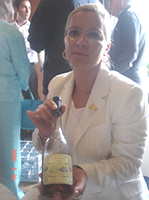 When you think of Tocai, the image conjured up is that of Tocai Friuliano or Tocai Italico, a white quaffable wine you can find as house wine in most restaurants in Friuly. To French in Alsace it represents Tokay-Pinot Grigio they have been drinking all their lefe.Tocai Rosso is produced in central Veneto,around Vicenza.There is also a Tokaj wine from Hungary, which is very sweet, or is it a region they are talking about?
When you think of Tocai, the image conjured up is that of Tocai Friuliano or Tocai Italico, a white quaffable wine you can find as house wine in most restaurants in Friuly. To French in Alsace it represents Tokay-Pinot Grigio they have been drinking all their lefe.Tocai Rosso is produced in central Veneto,around Vicenza.There is also a Tokaj wine from Hungary, which is very sweet, or is it a region they are talking about?
There has been a lot of confusion. But it will be finally cleared up come April1, 2007. Through an order of the EU regulating authority nobody in the EU will be allowed to use 'Tocai' or any similar word except the region of Tokaj in North West Hungary for wines known as Tokaji.
Tocai has been produced for more than 150 years in Friuly and East of Venezia region. It is made from the varietal ' Sauvignasse', the same grape which produced very ordinary wines in Chile till the early 90s and the producers mistook the varietal as Sauvignon Blanc. With studies conducted with the help of Bordeaux this error was detected, all the old vines uprooted and fresh Sauvignon Blanc replanted, giving some excellent white wines.Tokay in Alsace is made from Pinot Grigio. When I asked Dr. Francesco Venier , Director of MBA in Wine Business, Trieste at a Friulu-Venezia-Giulia Seminar, he agreed but added ,' in these hilly areas of Friuly the grape grows wonderfully and gives us an aromatic wine'
The red Tokai is made from a clone of Grenache. The one I tasted at a wine dinner organised by Vicenza Qualita` in Vicenza during Vinitaly in April was too light in colour and body compared to the usual Grenache, but Germaine Barreto, General manager of Vicenza Chamber of Commerce for Promotion and the other local producers insisted that the DNA analysis shows that this grape is indeed a Granache.
Nicolin Dott. Giorgio Nicola, owner of Cantina dei Colli Berice makes red Tocai and is a Vice President of the regional Association in Vicenza. He insisted that the DNA analyses shows red Tocai to be same as Grenache and Carignan found in South of France. He is extremely upset with the Italian government for not presenting the case of Tocai properly.' I have documents to show that even 150 years ago we made the Tocai and perhaps longer. The French did not protest strongly and instead started buying property in Tokaj', he added.
 |
| Eniko Kiraly- holding a bottle of Hungarian Tocaj |
Hungarians have, of course their reasons to fight for the exclusivity. During the communist regime it did not matter as the wines were exported mainly to Russia. But after getting freedom from the communist regime, they faced marketing dificulties due to the prevailing confusion and loss of the Russian market. According to Eniko Kiraly, the PR Manager for the Tokaj Rennaissance, an Association of a majority of Tokaj producers, " We tried to reason with Italians but they did not budge from their stand of contnuing with Tocai. We even approached O.I.V. (International Institute of Vines and Wines)to whom both Italy and Hungary belong as members. They helped some but still the Italians did not give in. When we joined the EU in September, 2005 we were able to convince them and the final decision was given by them in our favour." Eniko was in Vinoble promoting Disznoko Aszu (sweet) Tokaji as well as dry wines which are being added constantly to the wine producers' portfolio in order to expand the market
Tokaj has been a region in Hungary where wines have been produced since 14th-15th century. 'there are written documents dated 1630 which talk of Pastor Sepsy Laczko´ Ma´te´ discovering the famous Aszu wines. Way back in 1737 a Royal decree allowed 30 villages to produce Tokaj wines,' she added. A folklore has it that the countess from Fiuly was married to the prince Furmintine of Tokaj in 17h century and was given 'Tocai' as dowry which implied that the rights to use the name were transferred legally.